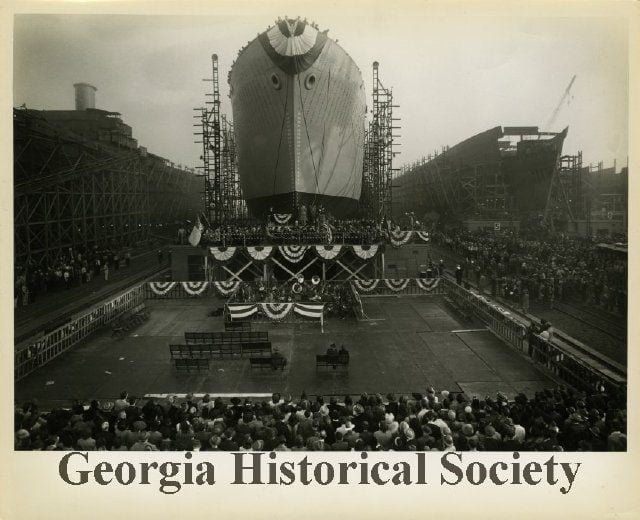During World War II, 173 Liberty ships were launched at Savannah and Brunswick. The ships delivered supplies to America’s allies.
Vessels were a lifeline to American allies during World War II
During World War II, 173 Liberty ships were launched at Savannah and Brunswick. They hauled trucks, tanks, ammunition, crated aircraft, heavy machinery and a wide range of other supplies, along with a singular priceless commodity, the promise of eventual victory.
Nationwide, 2,710 Liberty ships were produced at 18 shipyards. They were constructed to a specific size, 441-feet in length, and speed, 11.5 knots at full steam. In 1941, it required 244 days to complete one: By 1945, that had been sliced to 44 days. At sea, they formed, ship by ship, a lifeline to America’s allies.
The Savannah yard joined that connection first. It was located two miles downriver from the city, near Old Fort Jackson, and was constructed from scratch. “Nothing (was) out there. It was just woods,” recalled a Southeastern Shipbuilding Corp. employee.
A road was put down. Then 28,000 60-foot pine pilings were driven into the ground, and 355,000 cubic yards of fill placed on top. The yard quickly took shape. Thousands of employees were hired. And production started on May 22, 1942, on Southeastern’s first Liberty ship, the SS James Oglethorpe. Crewmen called her the “Jim.”
Six months later, on Nov. 20, 1942, Lucy Heard George, the wife of Georgia’s senior United States senator, smashed an 1857 bottle of champagne against her bow, and the Oglethorpe slid down the ways and into the Savannah River to the applause of thousands of onlookers. Much remained, however, to be done.
Finally, on Feb. 13, 1943, after passing dock and sea trials, the Oglethorpe was ready for duty. She sailed out of Savannah a few days later, loaded with steel, cotton and foodstuffs in her holds. Destination: New York and convoy assignment. There, her decks were lined with trucks, tractors, ambulances and aircraft. She departed on March 8, 1943. Destination: Liverpool, England. In her path: three packs of German U-boats.
On March 16, 1943, the Oglethorpe was struck by a torpedo, but stayed afloat. Early the next morning, on St. Patrick’s Day, two more torpedoes slammed into her. She sank several hours later. Of the 74 men aboard, 44 perished. In all, 13 cargo ships went down to U-boat attacks. It was the greatest convoy battle of the war.
Southeastern Shipbuilding soldiered on. The 96-acre site was eventually covered with 65 buildings that took up 500,000 square feet of floor space. Beyond that, the yard contained eight miles of railroad track, five locomotives, 13 gantry cranes and 21 locomotive cranes.
The workforce was likewise impressive. In December of 1943, at peak production, 15,303 men and women were employed on three shifts. Between 1942 and 1946, 46,766 workers clocked in. “It was the largest industry ever in Savannah,” said Tony Cope, author of “On the Swing Shift: Building Liberty Ships in Savannah.”
Nearly 70 miles down the Georgia coast, the Brunswick yard started months after Savannah, but quickly made up for lost time. The J.A. Jones Construction Co., which also operated a Liberty ship yard at Panama City, Fla., assembled an impressive operation on its 105-acre yard, located adjacent to the present-day Sidney Lanier Bridge.
Its peak employment number was 16,000, more than the population of Brunswick before the war started. Beyond work, the yard’s male and female employees bonded together through many activities, including a beauty pageant, and participation in seven war bond drives that helped finance the assembly of five B-29 bombers.
In November of 1944, the U.S. Maritime Commission asked all shipyards to produce six ships the next month. Brunswick went one better. On Christmas Day 1944, approximately 1,500 workers punched in at the yard. Welders. Riggers. Crane operators. Cafeteria workers. Bosses. And, one man dressed as Santa Claus. They signed their combined salary of $16,080 over to the war effort. J.A. Jones matched that amount.
With that extra day, Brunswick reached the seven-ship goal. It was the only yard in the nation to do so.
Just a few weeks later, on March 15, 1945, Brunswick launched its last Liberty ship, the SS Patrick B. Whalen. Through the course of the war, Savannah produced 88 Liberty ships, Brunswick 85. Of the 2,170 launched nationwide, only two have survived.
Sources: “World War II on the Savannah Waterfront in the American Theater of Operations: Wartime Production and Service in Savannah,” City of Savannah Research Library and Municipal Archives; “On the Swing Shift: Building Liberty Ships in Savannah,” by Tony Cope, Naval Institute Press, 2009; “Liberty Shipyards: The Role of Savannah and Brunswick in the Allied Victory, 1941-1945,” by Ashley Veasey, Georgia Historical Quarterly, Vol. 93, No. 2 (Summer, 2009); savahhahnow.com; dig.galileo.usg.edu; goldenislesmagazine.com.
